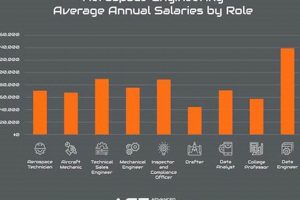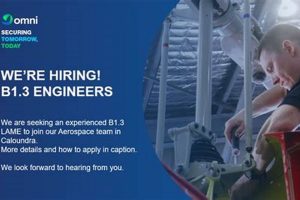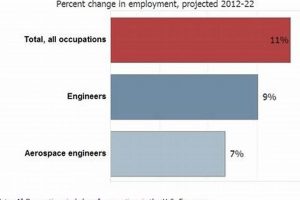Employment opportunities within the advanced air mobility sector, focusing on the design, manufacture, operation, and maintenance of electric vertical takeoff and landing (eVTOL) aircraft, represent a growing area of the aviation industry. These positions span a variety of disciplines, including engineering, software development, regulatory compliance, and pilot training, all tailored to the unique requirements of this emerging technology. For instance, an electrical engineer might specialize in developing high-power battery systems for eVTOL propulsion.
The significance of this sector lies in its potential to revolutionize urban transportation, reduce congestion, and offer sustainable alternatives to traditional aviation. The development of these aircraft also presents opportunities for economic growth and technological innovation. Historically, the field has drawn from both aerospace engineering and automotive industries, adapting existing technologies and developing new solutions to address the specific challenges of vertical flight.
The following sections will explore the various roles available, the skills and qualifications required, and the potential career pathways for individuals interested in participating in this rapidly evolving field.
The following provides insights into maximizing potential when seeking employment within the electric vertical takeoff and landing (eVTOL) sector.
Tip 1: Focus on Relevant Skills Development: Employers prioritize candidates with demonstrable experience in areas such as electric propulsion systems, battery technology, avionics, and autonomous flight control. Consider pursuing specialized coursework, certifications, or project-based learning to enhance these skills.
Tip 2: Understand Regulatory Frameworks: Familiarity with aviation regulations and certification processes, particularly those pertaining to eVTOL aircraft and urban air mobility, is crucial. Stay informed about evolving regulatory standards from agencies such as the FAA and EASA.
Tip 3: Emphasize Software Proficiency: Software plays a critical role in eVTOL operations, from flight control systems to passenger management platforms. Expertise in programming languages (e.g., Python, C++), simulation software, and data analysis techniques is highly valued.
Tip 4: Highlight Experience with Composites and Lightweight Materials: eVTOL aircraft rely heavily on advanced materials to achieve optimal performance and efficiency. Demonstrate proficiency in the design, analysis, and manufacturing of composite structures.
Tip 5: Cultivate Networking Opportunities: Attend industry conferences, workshops, and career fairs to connect with professionals and potential employers. Active participation in online forums and professional organizations can also expand your network.
Tip 6: Tailor Resume and Cover Letter: Generic applications are often overlooked. Customize your resume and cover letter to specifically address the requirements outlined in each job description, highlighting relevant skills and experience.
Tip 7: Research Companies Thoroughly: Before interviewing, conduct thorough research on the companies you are targeting. Understand their specific technologies, business models, and strategic goals to demonstrate genuine interest.
Adhering to these guidelines should increase the likelihood of success in securing a position within the burgeoning advanced air mobility field.
The subsequent sections will delve into specific company spotlights and future outlook for the industry.
1. Engineering
Engineering forms the cornerstone of vertical aerospace endeavors, directly impacting the creation, functionality, and safety of electric vertical takeoff and landing (eVTOL) aircraft. The demand for specialized engineers stems directly from the intricate design challenges associated with eVTOL technology. For instance, electrical engineers are crucial for developing high-density battery systems and efficient electric motors. Aerospace engineers focus on aerodynamics, structural integrity, and flight control systems, ensuring stability and maneuverability. Software engineers are vital for creating autonomous flight algorithms and navigation software. The presence of skilled engineering talent is not merely desirable but a prerequisite for the sustained growth and operational viability of vertical aerospace companies.
The practical significance of engineering extends beyond initial design and development. Continuous improvement, safety enhancements, and regulatory compliance rely heavily on ongoing engineering efforts. For example, materials engineers explore advanced composites to reduce weight and increase aircraft efficiency. Reliability engineers analyze component performance to identify potential failure points and implement preventative maintenance measures. This continuous cycle of innovation and refinement underscores the essential role of engineering in maintaining the competitiveness and safety standards within the field. Engineering jobs are therefore not static but evolve with technological advancements and increasing regulatory demands.
Ultimately, the success of vertical aerospace relies on attracting and retaining top engineering talent. Challenges include a global competition for skilled engineers, the need for specialized training programs to address the unique demands of eVTOL technology, and the importance of fostering a collaborative environment where engineers from diverse disciplines can effectively contribute. Recognizing and addressing these challenges is pivotal for enabling sustainable growth and ensuring the long-term viability of this emerging industry.
2. Manufacturing
Manufacturing constitutes a critical component of the vertical aerospace sector, directly influencing the creation of electric vertical takeoff and landing (eVTOL) aircraft and, consequently, the types and availability of employment opportunities. The specific manufacturing processes and techniques employed within this industry necessitate a skilled workforce and drive the demand for specialized expertise.
- Advanced Materials Fabrication
The construction of eVTOL aircraft relies extensively on advanced materials, such as carbon fiber composites and lightweight alloys, to achieve optimal strength-to-weight ratios. Manufacturing processes involve intricate layering, curing, and precision molding techniques. This necessitates skilled technicians, composite engineers, and quality control specialists. The production of these materials directly impacts the aircraft’s performance, fuel efficiency, and safety.
- Precision Assembly and Integration
Assembling eVTOL aircraft requires meticulous attention to detail and adherence to stringent tolerances. The integration of propulsion systems, avionics, control systems, and electrical components demands skilled technicians, mechanical engineers, and integration specialists. Errors in assembly can compromise aircraft performance, safety, and reliability. The manufacturing processes involve robotics, automated assembly lines, and manual adjustments to ensure precise fit and functionality.
- Quality Control and Assurance
Rigorous quality control and assurance procedures are vital to ensure the safety and reliability of eVTOL aircraft. These processes involve non-destructive testing, dimensional inspections, and functional testing of components and systems. Quality control specialists, inspectors, and metrologists play a crucial role in identifying and rectifying defects. Adherence to stringent quality standards, such as those established by aviation regulatory authorities, is paramount.
- Supply Chain Management
Efficient supply chain management is crucial for ensuring the timely delivery of components and materials to support the manufacturing process. This involves coordinating with suppliers, managing inventory levels, and optimizing logistics. Supply chain specialists, procurement managers, and logistics coordinators are essential for minimizing disruptions and ensuring cost-effectiveness. Disruptions in the supply chain can significantly impact production schedules and aircraft delivery timelines.
The manufacturing sector, therefore, not only produces the physical aircraft but also directly shapes the demand for specific skills and expertise. The need for proficiency in advanced materials, precision assembly, quality control, and supply chain management creates a diverse range of employment opportunities within the vertical aerospace industry, making it a significant driver of job growth and technological advancement.
3. Regulations
Regulatory frameworks exert a profound influence on the vertical aerospace sector, shaping the nature and availability of employment opportunities. The strict certification standards mandated by aviation authorities like the FAA and EASA necessitate specialized expertise in compliance, safety engineering, and risk management. For example, the design and development of electric vertical takeoff and landing (eVTOL) aircraft must adhere to stringent safety requirements, driving demand for engineers and technicians familiar with aviation regulations. Similarly, the operational aspects, including pilot training and air traffic management, are subject to regulatory oversight, creating positions for certified flight instructors, safety auditors, and air traffic controllers with specific knowledge of eVTOL operations.
The practical significance of understanding the regulatory landscape extends to various facets of vertical aerospace careers. Engineers must design aircraft that meet stringent safety and performance standards, requiring knowledge of airworthiness certification processes. Manufacturing processes must comply with quality control standards and traceability requirements, necessitating skilled technicians and quality assurance personnel. Operators must navigate complex airspace regulations and secure operational approvals, driving the need for regulatory affairs specialists and aviation lawyers. For instance, companies pursuing type certification for their eVTOL aircraft employ teams of experts dedicated to navigating the regulatory process and ensuring compliance with all applicable requirements. Any deviation from regulatory standards can result in significant delays, financial penalties, and reputational damage.
In conclusion, regulations form an integral component of the vertical aerospace ecosystem, directly impacting job roles and skill requirements. The demand for specialized expertise in compliance, safety, and risk management is paramount for ensuring the safe and efficient operation of eVTOL aircraft. Navigating the complex regulatory landscape presents ongoing challenges, requiring continuous adaptation and innovation. A thorough understanding of regulatory frameworks is therefore essential for individuals seeking to thrive in this rapidly evolving field.
4. Software
Software is integral to the vertical aerospace sector, driving the functionality, safety, and efficiency of electric vertical takeoff and landing (eVTOL) aircraft. The demand for software specialists reflects the complex operational requirements and advanced technologies inherent in this industry.
- Autonomous Flight Control Systems
The development of autonomous flight control systems necessitates sophisticated algorithms for navigation, obstacle avoidance, and trajectory planning. Software engineers are responsible for creating and testing these systems, ensuring safe and reliable operation without direct human input. For example, real-time sensor data processing and decision-making algorithms are crucial for autonomous navigation in urban environments. Positions in this area often require expertise in artificial intelligence, machine learning, and control theory.
- Flight Management and Simulation Software
Flight management software enables pilots to plan and execute flights efficiently, while simulation software is used for training and testing new aircraft designs. Software developers create user-friendly interfaces and develop realistic simulations of flight conditions. This includes simulating weather patterns, turbulence, and aircraft performance. Aviation companies utilize advanced software to optimize flight routes, reduce fuel consumption, and enhance safety protocols.
- Air Traffic Management Integration
Integrating eVTOL aircraft into existing air traffic management systems requires advanced communication and coordination software. Software engineers design systems that allow eVTOL aircraft to communicate with air traffic controllers and other aircraft, ensuring safe and efficient airspace management. This involves developing protocols for data exchange, conflict resolution, and emergency response. The implementation of these systems is crucial for the widespread adoption of eVTOL technology in urban areas.
- Maintenance and Diagnostic Software
Software is used to monitor the performance of eVTOL aircraft, diagnose potential problems, and schedule maintenance. Software developers create diagnostic tools that analyze sensor data, identify anomalies, and predict maintenance needs. Predictive maintenance algorithms help to prevent costly repairs and minimize downtime. These systems enable efficient maintenance operations and ensure the continued airworthiness of eVTOL aircraft.
The significance of software in vertical aerospace extends beyond individual aircraft operations, encompassing the entire ecosystem of urban air mobility. Software specialists are crucial for creating safe, efficient, and sustainable transportation solutions. The demand for these skills reflects the increasing reliance on advanced technologies to manage the complexities of vertical flight and integrate eVTOL aircraft into urban environments.
5. Operations
The operational component of the vertical aerospace sector directly influences the demand for, and nature of, employment opportunities. Operational activities encompass the practical aspects of deploying and maintaining electric vertical takeoff and landing (eVTOL) aircraft. This includes flight planning, ground operations, maintenance procedures, and adherence to safety protocols. The efficiency and effectiveness of these operations are directly linked to the skill sets and expertise required of personnel in various roles.
For example, the establishment of vertiports, the landing and takeoff infrastructure for eVTOL aircraft, necessitates specialized personnel to manage ground operations, passenger handling, and aircraft servicing. Flight dispatchers require comprehensive knowledge of flight planning, weather conditions, and airspace regulations. Maintenance technicians need specific training in eVTOL systems and components to ensure the continued airworthiness of the fleet. Real-world examples demonstrate that successful eVTOL operations rely on a highly trained workforce capable of adapting to the unique challenges posed by vertical flight. Companies like Joby Aviation and Archer Aviation are investing heavily in training programs to develop the operational expertise needed to support their aircraft deployments.
Ultimately, the seamless integration of eVTOL aircraft into existing transportation networks hinges on efficient and reliable operations. Challenges include developing standardized operational procedures, ensuring passenger safety, and managing airspace congestion. A thorough understanding of the operational aspects of vertical aerospace is therefore essential for individuals seeking careers in this burgeoning field, as it provides critical insight into the skill sets and knowledge required to contribute effectively to the industry’s growth and success. Future innovations in operational technologies and procedures will continue to shape the evolution of employment opportunities within this sector.
Frequently Asked Questions
This section addresses common inquiries regarding employment opportunities within the vertical aerospace industry.
Question 1: What specific engineering disciplines are most relevant to the vertical aerospace sector?
Aerospace, electrical, mechanical, and software engineering disciplines are all highly relevant. Expertise in areas such as aerodynamics, electric propulsion systems, composite materials, and autonomous flight control is particularly valuable.
Question 2: What are the primary skills and qualifications sought by employers in vertical aerospace manufacturing?
Proficiency in advanced materials fabrication, precision assembly techniques, quality control processes, and supply chain management is essential. Experience with aerospace manufacturing standards and regulations is also highly desirable.
Question 3: How do regulatory requirements impact employment opportunities in the vertical aerospace industry?
Compliance with aviation regulations necessitates specialized expertise in safety engineering, risk management, and certification processes. This drives demand for regulatory affairs specialists, safety auditors, and engineers with knowledge of airworthiness standards.
Question 4: What software skills are most valuable for roles in vertical aerospace?
Expertise in autonomous flight control algorithms, simulation software, air traffic management integration, and maintenance diagnostic tools is highly sought after. Proficiency in programming languages such as Python and C++ is also beneficial.
Question 5: What types of operational roles are emerging within the vertical aerospace sector?
Emerging operational roles include vertiport managers, flight dispatchers, maintenance technicians, and safety officers. These positions require specialized training in eVTOL aircraft systems, airspace regulations, and emergency response procedures.
Question 6: How does one gain relevant experience in vertical aerospace if lacking direct industry experience?
Relevant experience can be acquired through specialized coursework, internships, participation in industry conferences, and contributions to open-source projects. Networking with professionals in the field and showcasing relevant skills through personal projects can also enhance career prospects.
These responses offer a concise overview of key considerations for those interested in pursuing careers within the vertical aerospace sector.
The subsequent section provides a concluding summary of the key points discussed throughout this article.
Vertical Aerospace Jobs
This exploration has outlined the multifaceted nature of employment opportunities within the vertical aerospace sector. From engineering and manufacturing to regulations, software, and operations, each component demands specialized skills and expertise. The analysis has demonstrated how the industry’s growth is intrinsically linked to technological advancements, evolving regulatory frameworks, and the ongoing need for a highly skilled workforce.
The continued development and integration of electric vertical takeoff and landing (eVTOL) aircraft promise to reshape urban mobility and generate new economic opportunities. As the sector matures, a proactive approach to skills development and a thorough understanding of the industry’s complexities will be essential for individuals seeking to contribute to this transformative field. Monitoring advancements in technology, regulations, and industry practices remains crucial for sustained success in the arena of vertical aerospace jobs.







